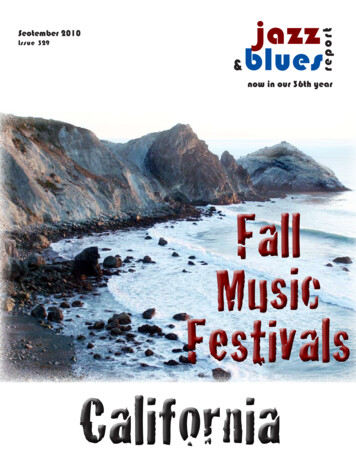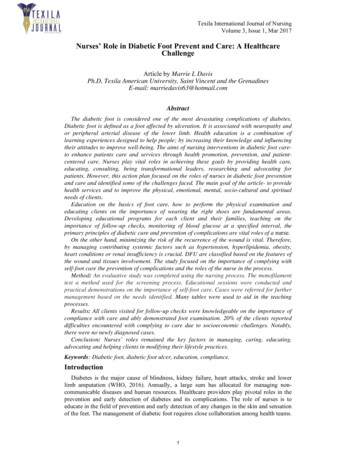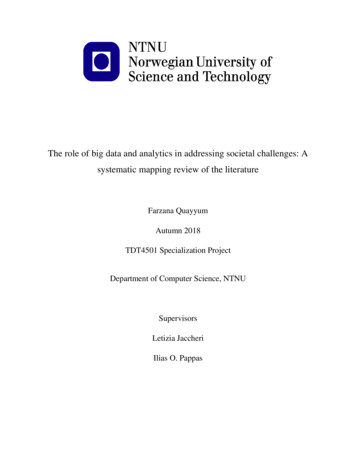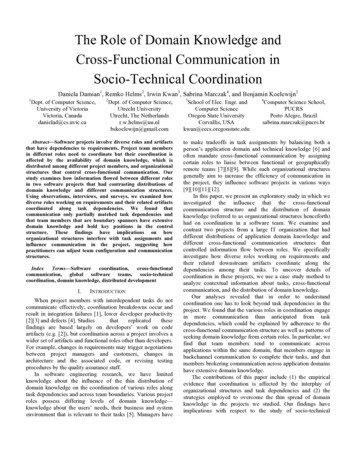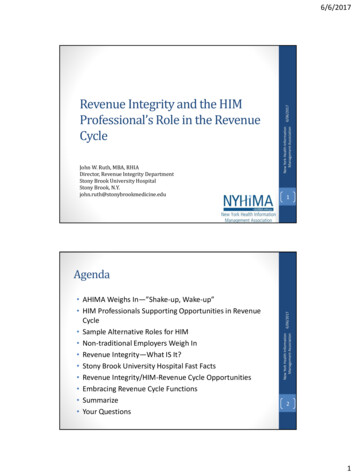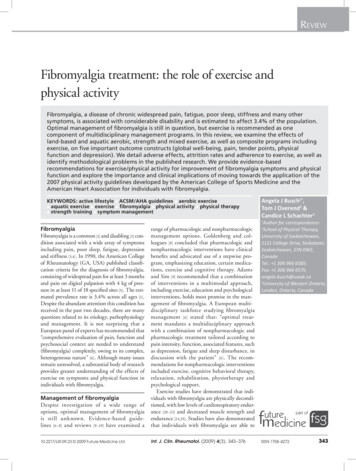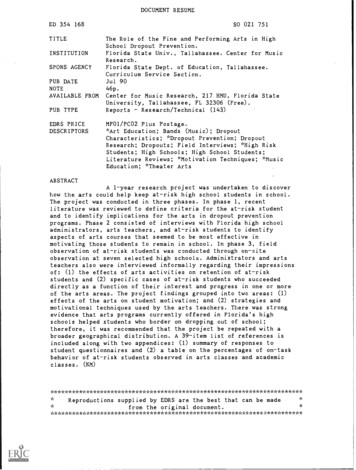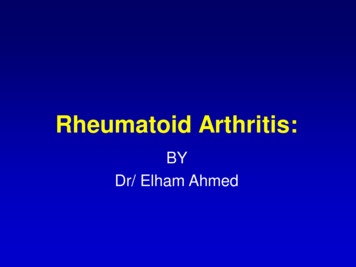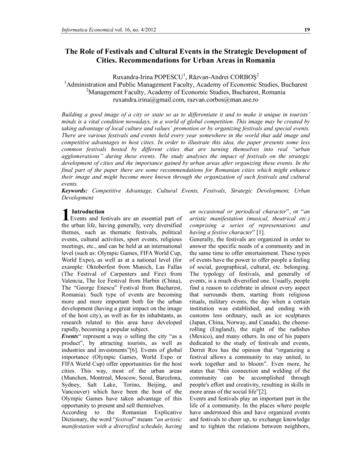
Transcription
Informatica Economică vol. 16, no. 4/201219The Role of Festivals and Cultural Events in the Strategic Development ofCities. Recommendations for Urban Areas in Romania1Ruxandra-Irina POPESCU1, Răzvan-Andrei CORBOŞ2Administration and Public Management Faculty, Academy of Economic Studies, Bucharest2Management Faculty, Academy of Economic Studies, Bucharest, Romaniaruxandra.irina@gmail.com, razvan.corbos@man.ase.roBuilding a good image of a city or state so as to differentiate it and to make it unique in tourists’minds is a vital condition nowadays, in a world of global competition. This image may be created bytaking advantage of local culture and values’ promotion or by organizing festivals and special events.There are various festivals and events held every year somewhere in the world that add image andcompetitive advantages to host cities. In order to illustrate this idea, the paper presents some lesscommon festivals hosted by different cities that are turning themselves into real “urbanagglomerations” during these events. The study analyses the impact of festivals on the strategicdevelopment of cities and the importance gained by urban areas after organizing these events. In thefinal part of the paper there are some recommendations for Romanian cities which might enhancetheir image and might become more known through the organization of such festivals and culturalevents.Keywords: Competitive Advantage, Cultural Events, Festivals, Strategic Development, UrbanDevelopment1IntroductionEvents and festivals are an essential part ofthe urban life, having generally, very diversifiedthemes, such as thematic festivals, politicalevents, cultural activities, sport events, religiousmeetings, etc., and can be held at an internationallevel (such as: Olympic Games, FIFA World Cup,World Expo), as well as at a national level (forexample: Oktoberfest from Munich, Las Fallas(The Festival of Carpenters and Fire) fromValencia, The Ice Festival from Harbin (China),The “George Enescu” Festival from Bucharest,Romania). Such type of events are becomingmore and more important both for the urbandevelopment (having a great impact on the imageof the host city), as well as for its inhabitants, asresearch related to this area have developedrapidly, becoming a popular subject.Events“ represent a way o selling the city “as aproduct”, by attracting tourists, as well asindustries and investments”[6]. Events of globalimportance (Olympic Games, World Expo orFIFA World Cup) offer opportunities for the hostcities. This way, most of the urban areas(Munchen, Montreal, Moscow, Seoul, Barcelona,Sydney, Salt Lake, Torino, Beijing, andVancouver) which have been the host of theOlympic Games have taken advantage of thisopportunity to present and sell themselves.According to the Romanian ExplicativeDictionary, the word “festival” means “an artisticmanifestation with a diversified schedule, havingan occasional or periodical character”, or “anartistic manifestation (musical, theatrical etc.)comprising a series of representations andhaving a festive character” [1].Generally, the festivals are organized in order toanswer the specific needs of a community and inthe same time to offer entertainment. These typesof events have the power to offer people a feelingof social, geographical, cultural, etc. belonging.The typology of festivals, and generally ofevents, is a much diversified one. Usually, peoplefind a reason to celebrate in almost every aspectthat surrounds them, starting from religiousrituals, military events, the day when a certaininstitution was established, and ending withcustoms less ordinary, such as ice sculptures(Japan, China, Norway, and Canada), the cheeserolling (England), the night of the radishes(Mexico), and many others. In one of his papersdedicated to the study of festivals and events,Derret Ros has the opinion that “organizing afestival allows a community to stay united, towork together and to bloom”. Even more, hestates that “this connection and welding of thecommunity can be accomplished throughpeople's effort and creativity, resulting in skills inmore areas of the social life”[2].Events and festivals play an important part in thelife of a community. In the places where peoplehave understood this and have organized eventsand festivals to cheer up, to exchange knowledgeand to tighten the relations between neighbors,
20Informatica Economică vol. 16, no. 4/2012there was also an improvement in the way thecommunity faces challenges and people havebecome more united.Also, events and festivals can result in theimprovement of the urban environment and of theinfrastructure. Many of the buildings built fordifferent important events (for example WorldExpo) have become with the passing of timeunique and defining symbols of the host city: TheEiffel Tour (built for the World Expo from Paris,1889), the German Hall (projected by Mies forthe Barcelona Expo, from 1929), the Atomium(built for the World Expo, 1958).During the most important events andinternational festivals, the host cities benefit froman intense promotion in the mass-media. As Getzhas mentioned, “the most important and relevantadvantage of the big events is that it allows thehost city to promotion and publicity in a shorttime frame” [3].As a conclusion, events and festivals represent agood way for the city to approach an “image”crisis, to revert the negative reputation and tobuild up a positive image. Festivals and eventsattract people towards the city and determinethem to travel in the area, succeeding this way toeliminate the negative imagine.2 Successful Festival and Events around theWorldEvery year in the world there are a multitude ofspecial festivals and events, some more knownthan others to the public. What's important is thatthese festivals and events generate an imageboost and offer plenty of advantages to the hostcity. In order to exemplify this, I've chosen topresent a couple of festivals hosted in differentcities, which become real “urban conglomerates”when they take place.Oktoberfest (Munich, Germany) is one of thegreatest public festivities in the world (Figure 1).Fig. 1.Images from the festivalSource: http://www.oktoberfest.de/en/The festival takes place every year in Munich,during 16 days, starting with the middle ofSeptember and ending in October (see Figure 2).Fig. 2.FestivallogoSource: http://www.oktoberfest.de/en/Every year, more than 6 million people take partin Oktoberfest, from which 72% are fromBavaria, 13% come from the rest of Germany,and 15% are foreign tourists (mainly fromEurope, USA, Australia and New Zealand) (seetable 1 and figure 3).
Informatica Economică vol. 16, no. 4/201221Table 1. The evolution of the number of tourists during the festival in the timeline 999Visitors 1200220032004200520062007200820092010Visitors ww.muenchen.de/Rathaus/tourist office/oktobfest/126031/oktoberfest Zahlen Statistiken.htmlApproximately 60% of the visitors have 30 yearsold, or less (according to the press release“Oktoberfest Munich as an economic factor”,released by the Munich City Department for866.76.56.45.96.6 6.7 6.96.56.4Work and Economic Development). Oktoberfesthas a big contribution to the economicdevelopment of the Munich city and theneighborhood area.6.96.56.35.546.55.95.96.166.25.7 6.420Fig. 3. The evolution of the number of tourists during the festival in the timeline 1990-2010During the 16 days of festival, tourists spendapproximately 830 million of Euros: 324 millionfrom the food carts, drinks and entertainment,205 million from shopping in Munich and usingthe public transportation, while 301 millionrepresents the profit of hotels and otheraccommodation spaces (see table 2).Table 2. Profit (mil. Euro)Food and drink324Shopping and public205transportationAccommodation301Total profit830Source: www.muenchen.de/Rathaus/tourist office/oktobfest/126031/oktoberfest Zahlen Statistiken.htmlThe Las Fallas festival (The Festival ofCarpenters and Fire) from Valencia is famousaround the world, as it is proclaimed to be anevent for international tourists around the world,which announces the arrival of Spring (Figure 4).
22Informatica Economică vol. 16, no. 4/2012Fig. 4.FestivallogoSource: http://www.fallasvalencia.es/During the festival hundreds of statues, calledninot (which can 10m taller), made from wood,carton or plastic are present during theprocession. The statues represent books andmovies characters, politicians, or celebrities (seeFigure 5). There are numerous of other activitieswhich take place during the festival, such as: bullfighting, paella competitions and beauty pageants(see Figure 5).Fig. 5.Images from the festivalSource: http://www.fallasvalencia.es“Las Fallas” festival attracts more than 1 milliontourists every year. 2011 was the rebirth year forthis festival, as the degree of occupancy of hotels100%95%95%during the festival has reached almost 100% (seeFigure 6).93%90%86%85%80%201120102009Fig.6. The degree of occupancy of hotels during the .htmlThe Snow Festival. Around the world there arefour main festivals dedicated to winter and to icesculptures, which take place every year in Harbin(China), Sapporo (Japan), Quebec (Canada) and
Informatica Economică vol. 16, no. 4/201223Norway. Sapporo is a city from Japan, situated inthe South-West of the Hokkaido Island and it'salso the biggest city on the island. Starting with1950, every winter in the month of February, atSapporo takes place the Snow Festival (seeFigure 7 and Figure 8) which attracts every timea big number of visitors (see Figure 9).Fig. 7.Festival logoSource: http://www.snowfes.com/english/Fig. 8.Images from the festivalSource: 08200720062005Fig. 9. The evolution of the number of visitors during the festival in the timeframe 2005-2011Source: Festival and Events Held in RomaniaThe pallet of festivals from Romania is very rich.Across the entire country you can encounterdifferent holidays and events which celebrate acertain thematic (Christmas or Ester traditions,popular traditions from different regions, music,film or art, popular cuisine, or even thematic lessencountered - although in Romania the rebel andnonconformist style is still regarded withsuspicion), and which attract every year a bignumber of both Romanian and foreign tourists.In order to understand better the festivals andcultural events which take place in Romania,further on there will be presented a classificationof the festivals according to their area of interest: music festivals (The “George Enescu”Festival and International Competition, SibiuJazz Festival, The International Festival"George Grigoriu", EUROPAfest, BestFest,
24Informatica Economică vol. 16, no. 4/2012The International Festival “The Golden Deer”,The Callatis Festival, The “Gaudeamus”Festival, The “Mamaia” Music Festival, TheMusical Autumn from Cluj etc.); movie and Animation Festivals (TheInternational Festival “Transilvania” (TIFF),“Anonymous” Festival, Anim'est Festival,The Historian Movie Festival from Rasnov,Asta Movie Festival, BEST Movie Festival,DaKino Festival, “Bucharest” InternationalMovie Festival etc.); theatre Festivals (SibFest, the tional Festival, B-Fit - Street TheaterFestival etc.).From the above, I'll summarize one of the eventswhich have a great economic and social impact:The “George Enescu” Festival (see figure 10).Held once every two years, since 1958, when itwas established in memoriam of the composerand pianist George Enescu (considered thefounder of the Romanian school of composition),the festival (now at its XX edition) has kept itstradition offering in 2011 an impressive number(almost 200) of symphonic and chamberconcerts, recitals, opera and ballet cology symposium, exhibitions of art,musical instruments, records, scores and books,and performances in the Festival Piazza. Allthese make the “George Enescu” Festival to be inthe “galaxy of the virtuous”, next to the ), Aix-en-Provence and Saint-Denis(France).Fig.10.TheLogo of the festivalSource: http://www.festivalenescu.roThe festival was held between September 1 September 25, has 7 sections (“Great orchestrasof the world”, “Recitals and chamber concerts”,“Midnight concerts”, “Opera and balletperformances”, “Enescu and his contemporaries”and “Music in the XXI century”, “Worldmusic”), and had in its agenda classic music andcontemporary rhythms, merged with folk, tangoand jazz echoes. The music of Liszt, Berlioz,Bach, Debussy, Schumann, Leonard Bernsteinwas heard in the performances of some of theworld's greatest orchestra (Amsterdam BaroqueOrchestra, Paris Orchestra, The LondonSymphonic Orchestra, The Vienna Philharmonic,The “George Enescu” Orchestra and Choir), andpianists such as: Helene Grimaud - from France,Antonio Pappano - from England, Akeiko Ebi from Japan, Yundi Li - from China, andperformers such as: soprano Nuria Rial - fromSpain, soprano Valentina Coladonato - fromItaly. Altogether, at this event has participatedover 3,500 performers from approximately 45countries.One of the event's sponsors, Luca D'Agnese, thepresident and general director of Enel Romania,has said that this festival “is the event whichplaces Romania best on the cultural map of theworld, defining it as a space of civilization, andespecially of creativity” [5].The performances have taken place in moreRomanian cities - Bucharest (the RomanianAthenaeum, the Palace Hall, and the “MihailJora” Concert Studio), Cluj-Napoca (the TarguMures State Philharmonic) and Timisoara (theBanat Philharmonic). In order for allmelomaniacs to feel as if they are part of thefestival, the organizers have implemented the livestreaming technology, allowing some of thefestival's events to be followed live onwww.festivalenescu.ro.In 2011, the budget of the festival has surpassed8.1 millions of euros, from which approximately7.6 millions of euros have come from publicfunding, and the rest from sponsors(approximately 500.000 euros) and from theselling of tickets (over 125.000 tickets subscriptions and single tickets). According tothe organizers, the price of one ticket wasbetween 40 and 90 lei (9.5 and 21.5 euros). At anaverage price of 65 lei, the organizers havesucceeded to rise only from the selling of tickets8.1 mil. lei (approximately 1.9 mil. euro). Evenfrom the first days of selling individual tickets,29 events have been “sold-out”, and two daysbefore the festival started, 42 events have beenexhausted. In other words, the occupancy rate hassurpassed 96%.In 2011, the budget of the festival has surpassed8.1 millions of Euros, from which approximately7.6 million of Euros have come from publicfunding, and the rest from sponsors(approximately 500.000 Euros) and from theselling of tickets (over 125.000 tickets -
Informatica Economică vol. 16, no. 4/2012subscriptions and single tickets). According tothe organizers, the price of one ticket wasbetween 40 and 90 lei (9.5 and 21.5 Euros). At anaverage price of 65 lei, the organizers havesucceeded to raise only from the selling of tickets8.1 million lei (approximately 1.9 million Euros).Even from the first days of selling individualtickets, 29 events have been “sold-out”, and twodays before the festival started, 42 events havebeen exhausted. In other words, the occupancyrate has surpassed 96%.In 2011, the festival has registered a total recordof people: 10.000 spectators per day. The“George Enescu” festival has brought almost16.000 foreign tourists in Romania who havetaken part in the performances in Bucharest andthe rest of the country.According to Mediafax, the 2011 “GeorgeEnescu” Festival has been included in an annualselection of the most prestigious thematic(cultural, musical and artistic) destinations fortourists, made by the Austrian economicmagazine “Gewinn” [4]. This selection has beenpublished in the first number of 2011 of the bimonthly Austrian magazine which had asthematic the most important cultural, musical andartistic events from 2011. Although, this wasn'tan actual ranking, Romania has occupied the 16place as destination, being recommended for the2011 “George Enescu” Festival [4].4 Conclusions“The industry of festivals and events has starteddeveloping from the beginning of the 1990, andtoday there is a vivid interest for any kind of25festival and event, at an international, nationaland local level. Festivals help promoting theareas in which they take place, attract numeroustourists, and can be regarded as a new type oftourism”[2]. The image of a destination, productor service can be improved or worsen thanks ordue to the success or failure of a festival or event.The characteristics of festivals and events areunique, and this is the main reason why we can'thave a standard management model to fit all ofthem. No matter the reason why an event wasorganized, there are numerous participants, andeach has his own expectations.In Romania, festivals and events have started toconquer new grounds, and organizers try to bringto Romania the ideas from abroad, and toorganize international festivals. It's highlyimportant, when such a festival or event isorganized, to take into consideration all theaspects: economic, social, cultural, and also thefuture aspects which are going to have an impacton that certain area, after the festival is over. If, atthe end the festival the outcome isn't the desiredone, and the tourists and participants aren'tsatisfied, they'll keep in mind to never come backto this event, and it will be difficult for theorganizers to win back their public.This is way, a big event needs to be very wellplanned and to take into account all aspects, insuch a way that everybody has to win.For a greater impact, organizers should take intoconsideration organizing the event in a logicalorder (see Figure 11), in such a way that theimpact will be the greatest, the organization willbe thorough, and the participants will be satisfied.Fig. 11.The logical schema when planning an eventSource:[7]For a good development it's essential to respectStep 2: Identifying the needs (see table 3). Thisstep sets the organizational requirements, andalso the needs of the public/tourists, as well asparticipants. The stage of identifying the needscan have exceptional results and all the „actors”can win, if it's well done. Step 3 can be madedirectly by the company which organizes theevent, or by a consultancy firm. It's importantthat these needs cover in an objective way the
26Informatica Economică vol. 16, no. 4/2012idea of the festival and the expectations of allinvolved parties.Table 3.Identifying the needs of a cultural event/festivalOrganizational needsPublic/ tourists needsParticipants needs satisfying the interest participating in a quality increasing the number of touriststowards culture and music;contest/event/ festival;and visitors during the festival; satisfying the interest having a proper musical increasing the resulted profittowards the tourist attractionssetting, professional and positioning the festival on newerfrom that certain city, orcompetitive;market segments (generally onRomania; having quality musicforeign musical markets); participating in a quality introducing new attractions for the conditions;festival having consistent prizes.spectators.Also, the cultural festivals organized inBucharest, or in any other big city, should focuson Step 3: Planning the event, and on Step 4:Implementing the event. These two stages areessential for the success or failure of the festival.Even if
Informatica Economică vol. 16, no. 4/2012 21 Table 1. The evolution of the number of tourists during the festival in the timeline 1990-2010 Year Visitors (million) Year Visitors (million) 1990 6.7 2000 6.9 1991 6.4 2001 5.5 1992 5.9 2002 5.9 1993 6.5 2003 6.3 1994 6.6 2004 5.9 1995 6.7 2005 6.1 1996 6.9 2006 6.5 1997 6.4 2007 6.2 1998 6.5 2008 6.0
